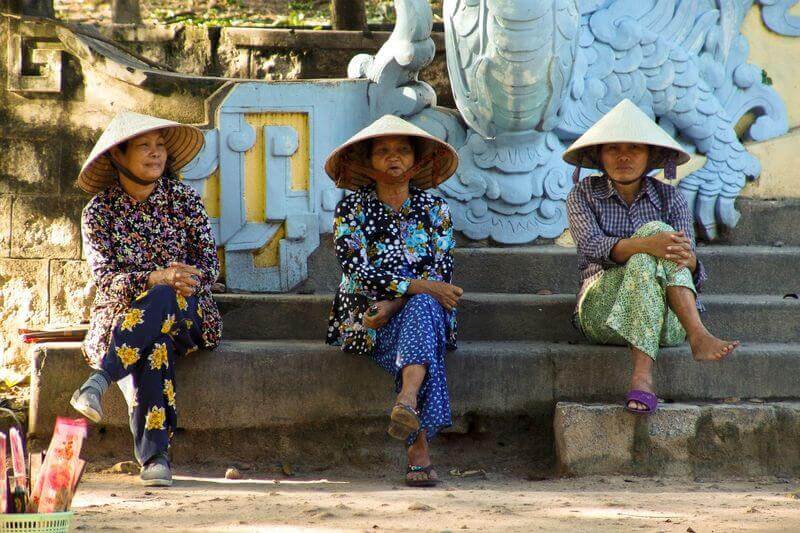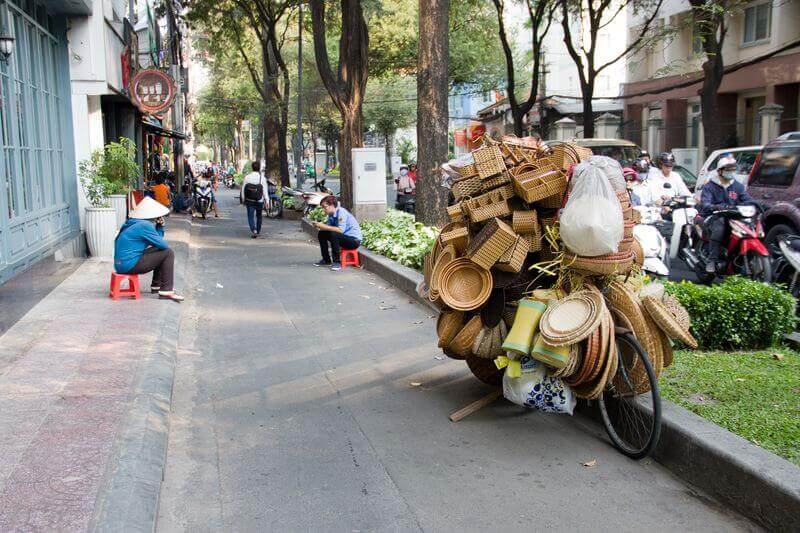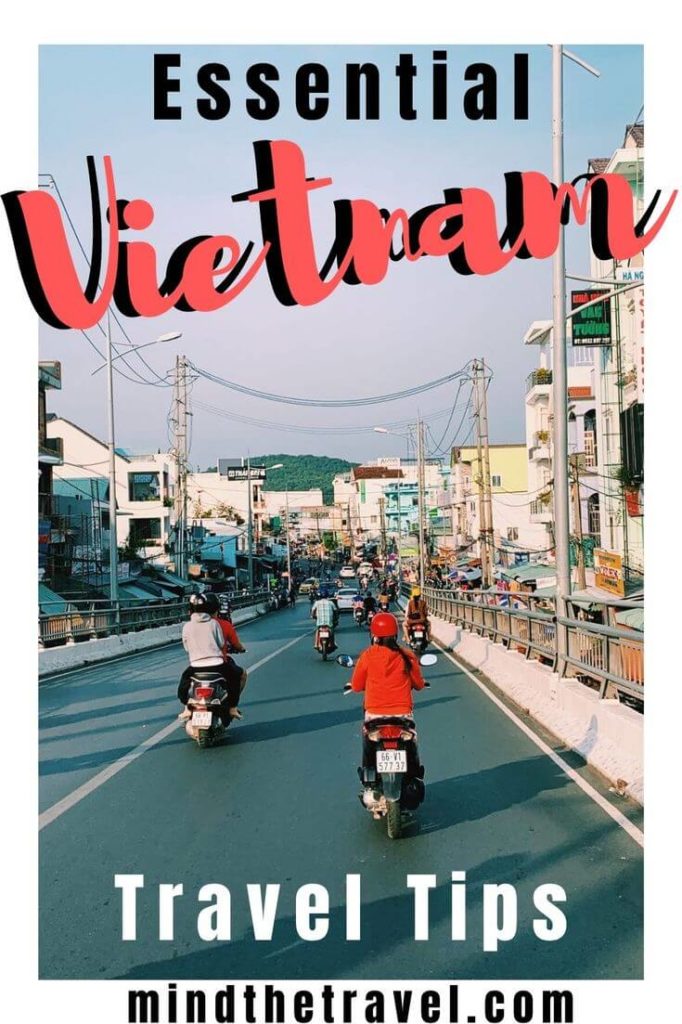27 Vietnam Travel Tips. Planning Your Vietnam Adventure
Embark on unforgettable Vietnam adventures with my Vietnam travel tips. This country is a destination that captivates travelers with its authentic charm and breathtaking landscapes, making it a favorite among Southeast Asian gems.
From the laid-back and welcoming nature of the locals to the tantalizing street food and the vibrant, bustling cities, Vietnam promises a mesmerizing experience that will linger in your memories long after you return home.
Whether you’re planning a short excursion or an extended stay, these helpful tips and tricks of traveling Vietnam are designed to enhance your journey and make it truly magical.

27 Vietnam Travel Tips. Planning Your Vietnam Adventure
Understanding Vietnam’s Visa Requirements
One crucial aspect to note before jetting off to Vietnam is the visa requirement.
As of 2020, tourists have several options to secure a tourist visa: visa on arrival, obtaining a visa from a Vietnamese embassy, or opting for an e-visa.
Visa on Arrival in Vietnam
For those choosing the visa on arrival route, the process is relatively straightforward but requires a bit of preparation.
Begin by obtaining an approval letter, which can be acquired through services like Vietnam-visa.com. A service fee of $34 for a 3-month, single-entry letter is customary.
Upon arrival in Vietnam, proceed to the visa on arrival/landing visa counter just before passport control.
Present two passport photos, your visa entrance letter, and a completed application form available on-site.
In case you forget photos, a small additional fee may be charged for an instant picture.
After submitting your documents, expect a brief wait—ranging from minutes to an hour—before your name is called at the counter.
Once processed, you’ll receive your passport back with the visa stamped inside, requiring a stamping fee of $25 for single entry or $50 for multiple entries (applicable for Americans).
Before leaving the counter, verify that the stamp reflects the correct visa details.
Once the process is complete, proceed through immigration.
In total, the visa on arrival process typically takes around an hour from disembarking the plane, ensuring a smooth entry into Vietnam.
Prepare thoroughly, follow these guidelines, and get ready to immerse yourself in the wonders of Vietnam.
Vietnam E-Visa
Vietnam has introduced e-visas as a streamlined process for tourists hailing from 80 different countries.
Interested travelers can apply for an e-visa directly through the official Vietnamese government website.
This electronic visa grants a single-entry stay of 30 days and is currently priced at around $25.
Unlike traditional visas, the e-visa does not receive a physical stamp in your passport. Instead, you’ll receive a letter that must be carried with you during your travels.
It’s essential to note that there are specific regulations regarding the entry and exit ports permissible with the e-visa.
Before finalizing your travel arrangements, ensure that your chosen ports align with the e-visa requirements to avoid any unexpected issues during your journey.
Instances have been reported where travelers with e-visas encountered difficulties, such as being denied entry for attempting to cross from Sapa to Laos by bus. As it was not an authorized port for their visa.
Alternatively, travelers can opt to apply for a Vietnam tourist visa at their local embassy, a process that varies based on the applicant’s country of origin.
Contact your nearest embassy directly to inquire about application procedures and associated fees for obtaining a visa stamped into your passport before departing from your home country.
The availability and requirements for obtaining a Vietnam tourist visa are contingent upon your country of residence.
For tailored information on your specific nation’s visa prerequisites, utilize resources like iVisa.com or reach out to the nearest Vietnamese embassy for comprehensive guidance.
Streamline your travel preparations by staying informed about the visa options that best suit your needs.

Best Time To Visit Vietnam
Vietnam welcomes visitors throughout the year, offering a mix of sunshine and rain during your stay.
For the most pleasant weather conditions, consider planning your visit between February and April or from August to October.
During these periods, temperatures are relatively moderate, and rainfall tends to be gentler, providing an optimal setting for exploration and enjoyment.
Vietnam Travel Cost
Traveling in Vietnam can be tailored to suit various budgets, ranging from frugal to more lavish experiences.
A reasonable daily budget for a fulfilling trip in Vietnam typically falls within the range of $25 to $30.
Opting for street food and hostel accommodations can significantly reduce costs, making Vietnam an affordable destination.
While currency conversions may require some adjustment (you might feel like a millionaire in Vietnam due to the exchange rates), you’ll soon acclimate to the local financial landscape.
Vietnam Packing List
When it comes to packing for Vietnam, remember the golden rule: less is more.
Similar to other Southeast Asian countries, you’ll find ample opportunities to purchase essentials locally. So there’s no need to overpack.
Consider leaving space in your luggage for tailored items from Hoi An, renowned for its skilled tailors who offer quality clothing at budget-friendly prices.
Essential items to include in your packing list are quick-dry clothing, a durable rain jacket, and reliable hiking boots or trainers.
Vietnam’s rugged terrain, except for its bustling urban centers, may require sturdy footwear and weather-appropriate attire.
Best Things to Do in Vietnam
With its vast and varied landscapes, Vietnam offers a plethora of captivating experiences, blending culture and adventure seamlessly into a one-stop destination. To ensure you make the most of your visit, here’s a curated list of must-do activities in Vietnam that promise unforgettable moments.
Embark on a Food Journey
Renowned for its delectable street food, Vietnam stands out as a culinary paradise in Southeast Asia.
Indulge in authentic dishes like pho, starting at an affordable $1 per bowl.
From savoring Bun Cha Hanoi to uncovering hidden culinary gems, a food trip in Vietnam epitomizes a cultural adventure not to be missed.
Insider Tip: Consider joining a food tour to explore a variety of local Vietnamese delicacies and enhance your gastronomic experience.
Engage in Cooking Classes
Immerse yourself in Vietnamese cuisine by participating in cooking classes, a delightful activity that offers a hands-on culinary experience.
Learn to prepare traditional dishes like spring rolls and pho, creating lasting memories and unique souvenirs from your journey.
Explore the various cooking classes available in Vietnam for an enriching cultural immersion.
Traverse the Country on a Motorbike Adventure
Experience the ultimate adventure by purchasing a motorbike and embarking on a journey from North to South (or vice versa) across Vietnam.
Revel in breathtaking viewpoints and scenic landscapes while relishing the freedom that personalized transportation provides.
Engage with local communities in lesser-known towns and savor authentic cultural encounters along the way.
Insider Tip: If driving a motorbike isn’t your forte, consider opting for a guided motorbike tour along some of Vietnam’s most picturesque routes for a safe and memorable exploration.
Discover the Charms of Hoi An
Delve into the enchanting ambiance of Hoi An, a UNESCO Heritage town celebrated for its vibrant food scene and captivating atmosphere.
Rent a bicycle to leisurely explore the historic old town and scenic beaches.
Don’t miss the opportunity to indulge in tailor-made clothing and immerse yourself in the unique charm of this beloved destination.
Unearth the wonders of Vietnam by embracing these diverse and enriching experiences, ensuring your journey is filled with unforgettable moments.
Roam Through Ho Chi Minh City
While bustling cityscapes aren’t my usual preference, the vibrant urban centers of Ho Chi Minh and Hanoi in Vietnam offer a distinctive charm that’s worth exploring.
Beyond the initial chaos and the omnipresent motorbike traffic, these metropolitan hubs boast a blend of attractions that cater to varied interests.
Ho Chi Minh City Highlights
In Ho Chi Minh City, immerse yourself in history and culture by visiting significant landmarks like the War Remnants Museum, Reunification Palace, and Notre Dame Cathedral.
Stroll through the bustling streets and experience the lively atmosphere of Pham Ngu Lao, reminiscent of the popular Khao San Road.
Indulge in delectable street food and affordable beverages while enjoying the city’s vibrant energy.
Ho Chi Minh City’s appeal extends to its proximity to captivating day trip destinations, including the Cu Chi Tunnels and the scenic Mekong River. Those offer enriching experiences for visitors.
Discovering Hanoi’s Charm
Contrasting with Ho Chi Minh City’s hustle, Hanoi exudes a more laid-back ambiance, perfect for a leisurely exploration.
Take in the picturesque Hoan Kiem Lake, Nha Tho Cathedral, and the charming Old Quarter. Allocate a minimum of two to three days to immerse yourself in the charm of Hanoi’s Old Quarter. Observe locals engaging in daily activities such as dining, driving, leisurely pursuits, and even grooming experiences like getting haircuts.
From Hanoi, consider embarking on excursions to iconic destinations like Halong Bay, Ninh Binh, and Sapa, each offering unique cultural and natural experiences.
Hanoi’s culinary scene beckons with affordable beer and vibrant curbside Vietnamese BBQs, providing an authentic dining experience that’s favored by locals.
Beach Escapes in Vietnam
Surprisingly, Vietnam’s coastal regions offer serene beach retreats ideal for relaxation and recreation.
Whether you choose to unwind in Mui Ne, Hoi An, Nha Trang, or the idyllic Phu Quoc Island, you’ll find a plethora of outdoor activities to enjoy.
Dive into the underwater wonders of Nha Trang or simply bask in the sun-kissed beaches, immersing yourself in the tranquil beauty of Vietnam’s seaside havens.
Embrace the diverse offerings of Vietnam, from dynamic city life to serene beach escapes, for a journey filled with enriching experiences and unforgettable moments.

Top Travel Tips For Vietnam
1. Navigating ATMs in Vietnam
When it comes to accessing cash in Vietnam, not all banks readily accept foreign credit and debit cards.
Keep an eye out for larger branches such as ACB, Sacombank, HSBC, and Citi Bank, where you are more likely to successfully withdraw money.
Typically, ATM withdrawals in Vietnam range from 2,000,000 to 3,000,000 VND (equivalent to $87 to $130), with fees varying between 30,000 to 60,000 VND ($3).
2. Financial Preparations for Travel
Navigating Vietnam’s financial landscape requires planning, as ATMs may have withdrawal limits and transaction fees ranging from $1 – $5.
Some establishments may not accept Visa cards, and those that do often levy additional charges.
To circumvent these challenges, consider obtaining a debit card that refunds international ATM fees, such as the Charles Schwab card, ensuring convenient access to funds without extra costs.
For earning rewards on expenses like accommodations and tours, the Chase Sapphire Preferred credit card is recommended.
Verify your bank’s international policies, including fee refunds and international charges, before departure to facilitate smooth financial transactions during your stay in Vietnam.
3. Staying Connected with a SIM Card
Maintaining an internet connection while traveling in Vietnam is essential. Especially if you plan on renting a scooter for exploring.
Data plans in Vietnam are budget-friendly, ensuring you stay connected throughout your journey.
Several telecom companies offer SIM cards in Vietnam, including Viettel, Mobiphone, and Vinaphone, with Viettel being a favored choice due to its widespread coverage and positive recommendations from fellow travelers.
I opted for Viettel and paid 170,000 VND ($7.50) for a SIM card with a 5GB data plan valid for 30 days. Topping up additional data is hassle – $5.50.
If you’re considering purchasing a SIM card at the airport upon arrival, exercise caution, as some travelers have reported being scammed.
To avoid any issues, it’s advisable to buy your SIM card directly from a reputable store rather than third-party vendors. It will ensure a smooth and trouble-free experience during your trip.
4. Vietnam Is a Cheap Country to Travel
Vietnam emerges as a budget-friendly destination for travelers, offering a mix of affordability and quality experiences.
While luxury options exist, exploring Vietnam on a moderate budget, like mine averaging $40-50 per day, is easily achievable.
5. Accommodation and Transport
Discover charming boutique hotels for $30-40 per night or cozy Airbnbs ranging from $20-25 per night.
Long-term stays in Vietnam can be budget-friendly, with apartments or houses available for $300-600 per month.
Trains and buses offer affordable and comfortable travel options, while using the Grab app for rides ensures cost-effective city transportation.
6. Dining and Shopping
Indulge in inexpensive dining experiences, with filling meals priced around $2 when dining on quaint plastics tools. Even upscale dining rarely exceeds $20 per person.
Enjoy domestic beers for less than $1 per can or bottle.
When shopping for souvenirs, engaging in haggling is common practice.
Start negotiations by offering 50% of the asking price, aiming to meet halfway for a fair deal.
7. Vietnam Language Tips
Prepare for limited English understanding by learning essential Vietnamese phrases for effective communication.
Mastering basic phrases like ‘thank you’ (‘cám on’ pronounced ‘gahm un’), ‘please’ (‘làm ơn’ pronounced ‘lahm uhn’), and ‘hello’ (‘xin Chào’ pronounced ‘sin chow’) can enhance your interactions with locals.
Understanding Vietnamese’s tonal nature is key to accurate communication, making it beneficial to familiarize yourself with common expressions before your journey.
While English is prevalent in Vietnam’s tourism sector, learning local phrases not only aids in communication during emergencies but also demonstrates cultural respect.
Embrace the challenge of Vietnamese language nuances, enriching your travel experience and fostering meaningful connections with the vibrant Vietnamese culture.

8. Wi-Fi Accessibility
In Vietnam, you’re in luck as Wi-Fi is widely available, especially in cafes, restaurants, and hostels.
Most places I visited provided free and reliable Wi-Fi for guests, including many local street food spots.
The only exceptions where Wi-Fi may be scarce are the smaller street carts.
9. Embracing the Motorbike Culture
Scooters dominate Vietnam’s roads, offering a quintessential way to explore the country.
While hopping on a scooter is a fantastic experience, ensure you are comfortable with driving before embarking on your journey.
If driving isn’t your preference, consider joining easy rider tours or utilizing Grab motorbike taxis for convenient travel options.
10. Legal Requirements and Safety Tips For Traveling to Vietnam
To drive legally in Vietnam, prioritize safety measures such as always wearing a helmet, possessing the required licenses (a motorcycle license from your home country and an international driving permit), and securing reliable travel insurance.
Given Vietnam’s high rate of motor vehicle-related incidents, it’s crucial to come prepared and exercise caution while on the road.
11. Navigating with Grab
For cost-effective and convenient transportation, rely on the Grab Taxi app, a popular choice for getting around Vietnam. Similar to Uber in Southeast Asia, Grab allows you to summon car or bike taxis effortlessly.
Consider adding your credit or debit card to the app for favorable rates.
Motorbike rides are typically more affordable than car rides, offering you a budget-friendly and authentic travel experience.
Expect to pay around $1 or less for a ride, depending on your destination.
12. Proactive Vietnam Tips
When using Grab, be prepared for drivers to request a positive rating or seek directions during your ride.
To streamline your journey, have your route mapped out on Google Maps beforehand, ensuring a smoother and more enjoyable travel experience in Vietnam.

13. Renting Motorbikes
For those considering renting a motorbike in Vietnam, expect to pay around 1 million VND or $45 per month or approx. 100,000 – 170,000 VND per day $4 – 7, depending on location and rental provider (summer 2019 rates).
While these figures fluctuate over time and vary across cities, having a ballpark estimate aids in assessing fair prices and avoiding overpayment during your travels.
14. Beware of Drive-By Theft
Stay vigilant against drive-by motorbike theft incidents, a prevalent concern in Vietnam. This is one of the most important safety tips for traveling in Vietnam.
Despite initial skepticism, experiencing such attempts firsthand can be alarming.
Secure your valuables, especially your phone and bag, as passing motorbikes may attempt snatch-and-grab tactics.
Theft and pickpockets remain a common issue in certain areas, emphasizing the importance of safeguarding your belongings and exercising caution.

15. Navigating Traffic and Street Crossings
Crossing the streets in Vietnam demands a unique approach due to the bustling motorbike-dominated traffic.
Drivers often prioritize flow over pedestrian rights, necessitating a different mindset when navigating roadways.
Here are some key tips for safely crossing Vietnamese streets:
- Pedestrians do not have the right of way; therefore, be prepared to yield to traffic;
- Traffic lights are not always obeyed, and many vehicles proceed through red lights;
- You can cross the street at any point, but exercise caution;
- Walk confidently when you spot a gap in traffic, trusting that drivers will maneuver around you;
- Avoid running while crossing as it disrupts driver predictions;
- Although intimidating, understand that drivers typically navigate around pedestrians without collisions;
- Sidewalks are often used for parking or driving rather than walking, so remain alert to your surroundings.
Traversing Vietnamese streets requires awareness, adaptability, and a willingness to embrace the unique traffic dynamics of the country.
Stay cautious, be confident in your movements, and navigate the bustling streets with care for a safe and enriching travel experience.
16. Embracing the Siesta Tradition
Similar to the siesta culture in Spain, Vietnam also observes midday breaks where most establishments, including tourist attractions, close around noon until 1 or 2 pm for rest.
Ensure to plan your Vietnam itinerary accordingly, checking ahead to confirm operational hours during these midday pauses to avoid disappointments.
17. Passport Handling in Accommodations
In Vietnam, it’s common for hotels and hostels to retain your passport upon check-in, utilizing it as collateral until your departure to prevent premature departures.
If uncomfortable with this practice, inquire if it’s possible to settle payments during check-in instead of check-out.
Typically, your passport should be returned post-payment.

18. Restroom Realities in Vietnam
Public toilets in Vietnam often lack essentials like toilet paper and soap, requiring visitors to adapt to local practices.
While Western-style toilets are prevalent, squat toilets may still be encountered.
Usage typically incurs a fee of around 2,000 VND, and cleanliness can vary, with toilet seats often wet due to water sprayers.
Carry tissues for seat wiping, as maintaining personal hygiene in such facilities can be a challenge.
19. Unveiling Hidden Gems
Exploring Vietnam’s charm involves seeking out hidden establishments tucked away in alleyways and side streets.
Entrances to these gems may not be prominently displayed on main roads, necessitating a keen eye for inconspicuous signs.
Embrace the adventure of discovering unique places like hostels accessed through convenience stores, adding an element of surprise to your journey.
20. Currency Management Strategy
In Vietnam, it’s advantageous to break down larger denominations into smaller bills for convenient transactions with local vendors.
When faced with difficulties in using 200,000 or 500,000 VND notes, visit a nearby convenience store to exchange them for smaller change.
This will simplify your interactions with merchants who prefer handling lower denominations.
21. Electrical Compatibility and Outlet Varieties
Vietnam’s outlets generally cater to both European and American plug types, featuring 220 volts for standard electrical connectivity.
While supporting flat two-prong American plugs and two round pins from Europe, outlets commonly lack a third hole for certain plug styles like the British variant.
Understanding these nuances ensures seamless device charging and usage during your stay.

22. Vegetarian-Friendly Dining
For vegetarian travelers in Vietnam, rejoice in the abundance of meat-free dining options available due to the country’s predominant Buddhist population.
Simply request “chay” when ordering to communicate your preference for vegetarian dishes, allowing you to savor traditional Vietnamese cuisine without meat-based ingredients.

23. Master the Art of Haggling
Embrace the art of negotiation while shopping in local markets across Vietnam, where vendors may initially quote inflated prices targeting tourists.
Employ your haggling skills by initiating bids at half the original price, aiming to reach a mutually agreeable cost between the initial quote and your offer.
If met with resistance, consider walking away. This is a tactic that often prompts vendors to reconsider and potentially offer a more reasonable price.
Additionally, explore various shops to compare prices and return to secure the best deal if necessary, leveraging local insights for successful bargaining experiences.

24. Affordable Travel with Sleeper Buses
Opting for sleeper buses in Vietnam presents a cost-effective and comfortable means of traversing long distances between key destinations.
This budget-friendly mode of transport allows passengers to recline during the journey, minimizing the need for overnight accommodations, thereby maximizing savings.
When embarking on sleeper bus travel, consider the following tips:
- Shoes are typically removed on the bus, with plastic bags provided for storage;
- Rest stops occur once or twice along the route, signaled by the bus honking; remain vigilant for your bus amidst the bustling stops;
- English explanations may be limited on sleeper buses;
- Foreign travelers are often allocated top bunks to cater to local Vietnamese clientele;
- Some destinations permit passengers to remain on the bus until 6 am if arriving early;
- When booking through accommodations, ensure you secure a receipt as the bus company may request it for validation.
25. Embrace Sustainability by Reducing Plastic Consumption
Vietnam’s prevalent plastic and single-use item consumption, particularly evident in its street food and motorbike culture, underscores the importance of minimizing plastic waste.
To contribute to environmental conservation efforts, equip yourself with reusable essentials such as a coffee mug, water bottle, tote bag, metal straw, and possibly a water filter.
Street vendors are accommodating towards the use of reusable items, fostering a collective effort towards reducing plastic reliance.

26. Shopping Advice for Clothing Enthusiasts
For travelers seeking quality and affordable clothing in Vietnam, Hoi An emerges as a prime destination renowned for exceptional tailor services.
When scouting for wardrobe additions, prioritize shopping in Hoi An or its adjacent regions as opposed to Ho Chi Minh City or Hanoi, where souvenir shops may offer inferior clothing quality unless custom tailoring is sought.

27. Indulge in Vietnam’s Coffee Culture
Immerse yourself in Vietnam’s rich coffee culture, a cornerstone of local traditions.
Embrace the diverse coffee offerings available at affordable prices, ranging from various styles of serving.
For fellow coffee enthusiasts, exploring the local Vietnamese coffee scene presents a delightful experience.
Refer to resources like guides on ordering coffee to enhance your coffee-centric journey in Vietnam.
Vietnam Travel Tips: Wrapping Up
Implementing these travel tips about Vietnam ensures a seamless and enriching exploration of the country, fostering sustainable practices while maximizing affordability and cultural immersion.
Share your own recommendations for Vietnam travel experiences in the comments!
PIN FOR LATER!






Bernice Abuan
I can’t wait to visit Vietnam with my friends (half my group is Vietnamese)! I’d definitely prefer to venture into the countryside than remain in the highly populated cities to truly experience real Vietnamese food, and culture that hasn’t been greatly changed from westernisation xx
Bernice | IG @bunnybernice
https://www.bunnybernice.com/single-post/2017/10/03/Classy-Invitation-Boxes-For-Your-Groomsmen
Taylor
Thanks for the info! This will be very helpful if I ever go to to Vietnam 🙂
Nina | Lemons and Luggage
Thank you for this! Vietnam is a country I have been longing to visit, and now it seems so much further away. But I hope these tips will be put to good use in the future.
Under Flowery Sky
So much informations. First I have to explore Thailand more or Malesia, but
I hope I’ll do Vietnam also. Thanks a lot..